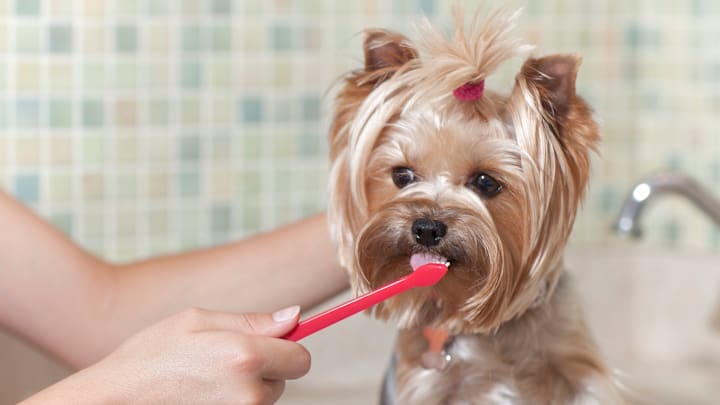When it comes to your dog’s oral health, prevention is the best medicine: Brushing your dog’s teeth for just a few minutes a day will help your pet live a healthier life.
Dental disease is a fairly common medical condition for dogs, with over 80 percent of dogs 3 years and older showing some signs of it. Good oral hygiene is important: Neglecting to clean your dog’s teeth can cause a host of dental issues like gingivitis, halitosis, periodontal disease, and worse. “Tooth infections and gum inflammation can lead to bacteria from the dog’s mouth translocating to its heart, kidney, or liver, and can be dangerous for your pet,” Dr. Laurie Bouchard, a veterinarian at Centre Vétérinaire Rive-Sud in Brossard, Quebec, tells Mental Floss. “These problems are preventable if you brush your dog’s teeth regularly and catch dental problems early.”
How Often to Brush a Dog’s Teeth
To help prevent dental problems, brush your dog’s teeth regularly. “Because tartar build-up can appear on a dog’s teeth within days, daily brushing is best,” Bouchard says. Daily brushing is especially important for small or toy breed dogs like chihuahuas [PDF] and Yorkshire Terriers, which suffer from more plaque accumulation and dental diseases than bigger breeds. Larger dogs can typically go two to three days between cleanings.

Good oral care for your dog isn’t complicated, but routine is key. “You should begin the daily habit of teeth brushing from the first day you have your pet,” Bouchard says. This is also the case for puppies, even though they’ll lose their baby teeth. The earlier you and your dog develop a routine, the better.
For best results, use a dog toothbrush made with ergonomic handles to help you easily reach your pet’s teeth. You can find specially formulated toothpaste in dog-friendly flavors such as chicken or beef.
When it comes to dogs that balk at their daily tooth cleaning, Bouchard advises to start by using your finger to carefully apply a little layer of doggie toothpaste to their teeth and gums. Once your pet gets used to that, move on to a finger brush, then a toothbrush. If your dog is still resisting, you can try grabbing a special tasteless and odorless dental water additive from your local pet store. You could also stock up on chew toys that contain oral enzymes that help prevent some plaque buildup, though brushing is still the optimal method.
You should also talk with your vet about scheduling professional dental cleanings for your dog as part of their routine maintenance.
Signs of Dental Diseases in Dogs
Even with regular brushing and professional cleanings, dogs can still develop dental diseases. Most often, the first sign of a canine dental disease isn’t be seen, but smelled. Pay attention if your dog’s breath suddenly smells worse; this may indicate a dental problem.

You should also contact your vet if you notice your pup chewing on one side of its mouth, dropping food, or not eating at all. If your dog’s gums are red—not pink—or bleeding, as this is also a cause for concern.
If your dog has a dental disease, your veterinarian will decide the best treatment plan. According to Bouchard, this typically involves putting your pet under anesthesia for their safety and comfort. The veterinarian will then give your dog a full dental cleaning, conduct an oral exam, and take x-rays of all their teeth to make sure they get the full picture of your pup’s oral health. Their priority is to clean and repair your dog’s teeth—but if too much damage is done, the infected tooth may need to be pulled.
